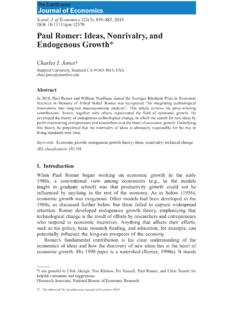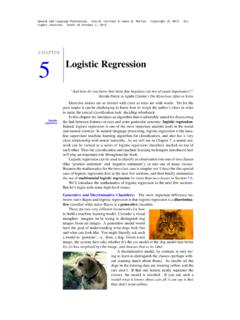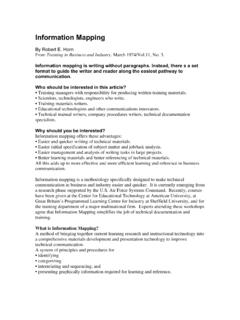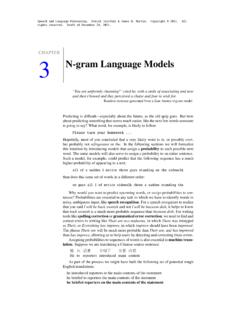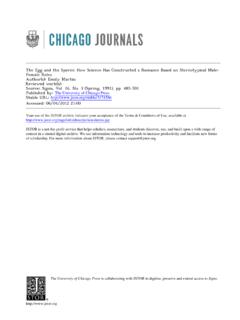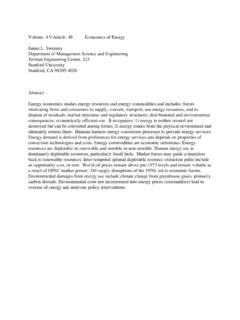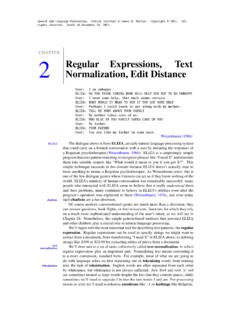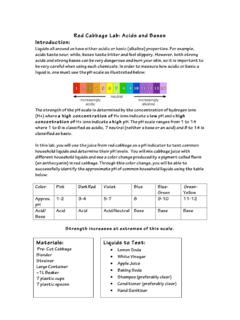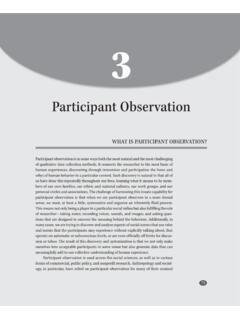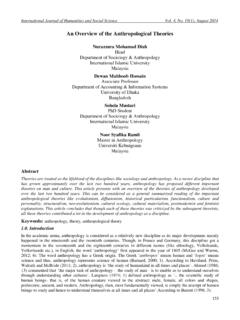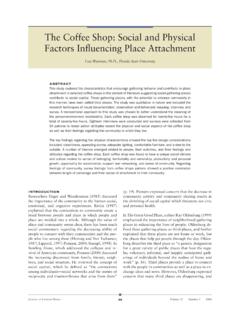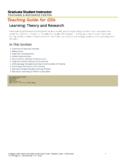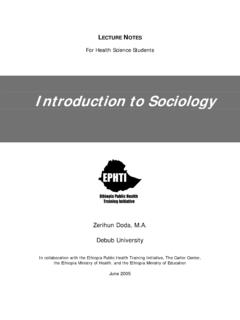Transcription of community of practice - Stanford University
1 To appear in 2006. Encyclopedia of language and linguistics. Elsevier. Communities of practice Penelope Eckert Abstract A community of practice is a collection of people who engage on an ongoing basis in some common endeavor. Communities of practice emerge in response to common interest or position, and play an important role in forming their members' participation in, and orientation to, the world around them. It provides an accountable link, therefore, between the individual, the group, and place in the broader social order, and it provides a setting in which linguistic practice emerges as a function of this link. Studies of communities of practice , therefore, have considerable explanatory power for the broader demographics of language variability. Key Words: speech community , community of practice , identity, practice , class, gender, variation, heterogeneity, sociolinguistics, linguistic anthropology, social stratification, social meaning.
2 The notion community of practice was developed by Jean Lave and Etienne Wenger (Lave and Wenger 1991; Wenger 2000) as the basis of a social theory of learning. A community of practice is a collection of people who engage on an ongoing basis in some common endeavor: a bowling team, a book club, a friendship group, a crack house, a nuclear family, a church congregation. The construct was brought into sociolinguistics (Eckert and McConnell-Ginet 1992; Eckert and McConnell-Ginet 1992) as a way of theorizing language and gender most particularly, of responsibly connecting broad categories to on-the-ground social and linguistic practice . The value of the notion communities of practice to Sociolinguistics and Linguistic Anthropology lies in the fact that it identifies a social grouping not in virtue of shared abstract characteristics ( class, gender) or simple co-presence ( neighborhood, workplace), but in virtue of shared practice .
3 In the course of regular joint activity, a community of practice develops ways of dong things, views, values, power relations, ways of talking. And the participants engage with these practices in virtue of their place in the community of practice , and of the place of the community of practice in the larger social order. The community of practice is thus a rich locus for the study of situated language use, of language change, and of the very process of conventionalization that underlies both. Two conditions of a community of practice are crucial in the conventionalization of meaning: shared experience over time, and a commitment to shared understanding. A community of practice engages people in mutual sense-making about the enterprise they're engaged in, about their respective forms of participation in the enterprise, about their orientation to other communities of practice and to the world around them more generally.
4 Whether this mutual sense-making is consensual or conflictual, it is based in a commitment to mutual engagement, and to mutual understanding of that engagement. Participants in a community of practice collaborate in placing themselves as a group with respect to the world around them. This includes the common interpretation of other communities, and of their own practice with respect to those Communities of practice 1. communities, and ultimately with the development of a style including a linguistic style that embodies these interpretations. Time, meanwhile, allows for greater consistency in this endeavor for more occasions for the repetition of circumstances, situations, and events. It provides opportunities for joint sense-making, and it deepens participants' shared knowledge and sense of predictability.
5 This not only allows meaning to be exercised, but it provides the conditions for setting down convention (Lewis 1969). The community of practice offers a different perspective from the traditional focus on the speech community as an explanatory context for linguistic heterogeneity. The speech community perspective views heterogeneity as based in a geographically defined population, and structured by broad and fundamental social categories, particularly class, gender, age, race and ethnicity. The early survey studies in this tradition (Labov 1966; Wolfram 1969; Trudgill 1974; Macaulay 1977) provided the backbone of variation studies, mapping broad distributions across large urban communities. What these studies could not provide is the link between broad, abstract patterns and the meanings that speakers are constructing in the concrete situated speech that underlies them.
6 The search for local explanations of linguistic variability has spurred a range of ethnographic studies over the years (Labov 1963; Gal 1979; Eckert 2000), and in recent decades the ethnographic trend has intensified. A major challenge in such studies is to find local settings in which speakers engage the most intensely in making sense of their place in the wider social world, and in which they articulate their linguistic behavior with this sense. The construct community of practice is a way of locating language use ethnographically so as to create an accountable link between local practice and membership in extra-local and broad categories. What makes a community of practice different from just any group of speakers ( a bunch of kids found hanging out on the street, or a group of undergraduates assembled for an experiment).
7 Is not the selection of the speakers so much as the nature of the accountability for this selection. While every community of practice offers a window on the world, the value of this approach relies on the analyst's ability to seek out communities of practice that are particularly salient to the sociolinguistic question being addressed. It is this selection that makes the difference between particularism and a close-up study with far-reaching significance. Explanation for broad patterns is to be found in speakers' experience, understanding, and linguistic development as they engage in life as members of important overarching categories. A. white working class Italian-American woman does not develop her ways of speaking directly from the larger categories working class, Italian-American and female, but from her day-to-day experience as a person who combines those three (and other) memberships.
8 Her experience will be articulated by her participation in activities and communities of practice that are particular to her place in the social order. It is in these communities of practice that she will develop an identity and the linguistic practices to articulate this identity. Thus communities of practice are fundamental loci for the experience of membership in broader social categories one might say that it is the grounded locus of the habitus (Bourdieu 1977). Survey studies show us that working class speakers lead in the adoption of local phonological change. While one can speculate about the motivations for this early adoption on the basis of general knowledge about class, the actual dynamics of social meaning can only be found I direct examination of working class linguistic practice .
9 Ethnographic work in Detroit suburban high schools (Eckert 2000) sought to understand the salience of class in adolescents' day-to-day practice . The study uncovered an opposition between two large communities of practice , the jocks and the burnouts, that constitute class cultures in the context of the high school. The working class culture of the burnouts and the middle class culture of the jocks are specifically adolescent, and class consciousness and conflict takes the form of a highlighted social opposition in school, and the maximization of resources in constructing the opposition. Linguistic variables, a prime Communities of practice 2. resource, correlatedsignificantly with participation in these communities of practice , rather than with parents' social class. The jocks' and burnouts' contrasting orientation to such things as school, the urban area, relationships, and the future, provided direct explanations for the burnouts' lead in the adoption of new local changes.
10 Another important aspect of the communities of practice approach is its focus on the fluidity of social space and the diversity of experience. The speech community perspective's focus on demographic categories implies a center and a periphery (Rampton 1999). The focus on average behavior for categories suggests a typical speaker, erasing the important activity of speakers at the borders of categories. This also produces a static view of the relation between the linguistic and the social, since change tends to come from the borders (Pratt 1988). Studies of communities of practice , therefore, can capture the interaction between social and linguistic change. Qing Zhang, for example (Zhang 2001), has captured the role of stylistic practice among the new Beijing yuppies in the development of new dialect features, and Andrew Wong (Wong in press).
